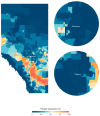Sociodemographic and Population Exposure to Upstream Oil and Gas Operations in Canada
- PMID: 39767531
- PMCID: PMC11675219
- DOI: 10.3390/ijerph21121692
Sociodemographic and Population Exposure to Upstream Oil and Gas Operations in Canada
Abstract
Canada, as one of the largest oil and gas producer in the world, is responsible for large emissions of methane, a powerful greenhouse gas. At low levels, methane is not a direct threat to human health; however, human health is affected by exposure to pollutants co-emitted with methane. The objectives of this research were to estimate and map pollutants emitted by the oil and gas industry, to assess the demographic of the population exposed to oil and gas activities, and to characterize the impact of well density on cardiovascular- and respiratory-related outcomes with a focus on Alberta. We estimated that ~13% and 3% people in Alberta reside, respectively, within 1.5 km of an active well and 1.5 km of a flare. Our analysis suggests that racial and socioeconomic disparities exist in residential proximity to active wells, with people of Aboriginal identity and people with less education being more exposed to active wells than the general population. We found increased odds of cardiovascular-related (1.13-1.29 for low active well density) and respiratory-related (1.07-1.19 for low active well density) outcomes with exposure to wells. Close to 100 countries produce oil and gas, making this a global issue. There is an important need for additional studies from other producing jurisdictions outside the United States.
Keywords: CanCHEC; DAD; air pollutants; air quality; methane; nitrous oxide; oil and gas.
Conflict of interest statement
The authors declare no conflicts of interest. The funders had no role in the design of the study; the collection, analyses, or interpretation of data; the writing of the manuscript; or the decision to publish the results.
Figures





Similar articles
-
Methane Emissions from Abandoned Oil and Gas Wells in Canada and the United States.Environ Sci Technol. 2021 Jan 5;55(1):563-570. doi: 10.1021/acs.est.0c04265. Epub 2020 Dec 15. Environ Sci Technol. 2021. PMID: 33322902
-
Air pollution, methane super-emitters, and oil and gas wells in Northern California: the relationship with migraine headache prevalence and exacerbation.Environ Health. 2021 Apr 17;20(1):45. doi: 10.1186/s12940-021-00727-w. Environ Health. 2021. PMID: 33865403 Free PMC article.
-
Methane Emissions from Abandoned Oil and Gas Wells in Alberta and Saskatchewan, Canada: The Role of Surface Casing Vent Flows.Environ Sci Technol. 2023 Dec 5;57(48):19594-19601. doi: 10.1021/acs.est.3c06946. Epub 2023 Nov 21. Environ Sci Technol. 2023. PMID: 37988112
-
The Minderoo-Monaco Commission on Plastics and Human Health.Ann Glob Health. 2023 Mar 21;89(1):23. doi: 10.5334/aogh.4056. eCollection 2023. Ann Glob Health. 2023. PMID: 36969097 Free PMC article. Review.
-
Advances in science and applications of air pollution monitoring: A case study on oil sands monitoring targeting ecosystem protection.J Air Waste Manag Assoc. 2019 Jun;69(6):661-709. doi: 10.1080/10962247.2019.1607689. J Air Waste Manag Assoc. 2019. PMID: 31082314 Review.
Cited by
-
Trace Metal and Metalloid Profiles in Hair Samples from Children in the Oil-Producing Region of Kazakhstan.Toxics. 2025 Jun 21;13(7):522. doi: 10.3390/toxics13070522. Toxics. 2025. PMID: 40710966 Free PMC article.
References
-
- IPCC . Contribution of Working Group I to the Sixth Assessment Report of the Intergovernmental Panel on Climate Change 2021. Cambridge University Press; Cambridge, UK: New York, NY, USA: 2023. IPCC Climate Change 2021: The Physical Science Basis.
-
- Garcia-Gonzales D.A., Shonkoff S.B.C., Hays J., Jerrett M. Hazardous Air Pollutants Associated with Upstream Oil and Natural Gas Development: A Critical Synthesis of Current Peer-Reviewed Literature. Annu. Rev. Public Health. 2019;40:283–304. doi: 10.1146/annurev-publhealth-040218-043715. - DOI - PubMed
-
- Warneke C., Geiger F., Edwards P.M., Dube W., Pétron G., Kofler J., Zahn A., Brown S.S., Graus M., Gilman J.B., et al. Volatile Organic Compound Emissions from the Oil and Natural Gas Industry in the Uintah Basin, Utah: Oil and Gas Well Pad Emissions Compared to Ambient Air Composition. Atmos. Chem. Phys. 2014;14:10977–10988. doi: 10.5194/acp-14-10977-2014. - DOI
MeSH terms
Substances
Grants and funding
LinkOut - more resources
Full Text Sources

